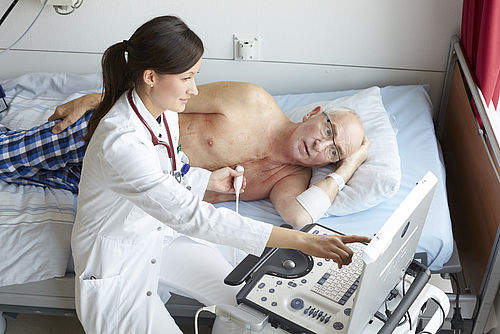Arrhythmias
A healthy heart beats about 60 to 100 times per minute in a regular rhythm. If the heart beats irregularly, too fast or too slow, this is called arrhythmia. Arrhythmias are among the most common heart diseases. In recent years, arrhythmias have become more and more frequent and the number of people who have died of them has also been steadily increasing.
Clinical Picture
There are different forms of arrhythmias, which are distinguished by the speed of heart rate they cause: bradycardic arrhythmias with too slow heartbeat (less than 60 beats per minute) and tachycardic arrhythmias with too fast heartbeat (more than 100 beats per minute). Frequently, additional heartbeats occur, called extrasystoles, which are felt like ‘heart stumbling’ and are usually harmless. Atrial fibrillation is the most common cardiac arrhythmia in Germany, affecting about 1 per cent of the population (about 800,000 people).
The first signs of cardiac arrhythmia can be fatigue or dullness during normal, habitual activities. Other possible symptoms include heart stumbling, a racing heartbeat, dizziness, light-headedness, confusion, fainting, short-term loss of consciousness, seizures, chest pain or angina. The most important examination to diagnose cardiac arrhythmia is the electrocardiogram (ECG). This is used to record heart activity under resting and stress conditions and over a longer time period (24 hours). Possible complications of cardiac arrhythmia include embolism, stroke, heart attack or developing heart failure. For example, a quarter of all strokes are caused by atrial fibrillation. Taking blood thinning medications can, over time, reduce the risk of stroke by 70 per cent.
Causes
Cardiac arrhythmias are most frequently caused by other, already existing heart diseases, such as coronary heart disease (CHD), heart attack, inflammation of the heart muscle, heart valve defects, heart failure or congenital heart defects. More rarely, diseases such as hyperthyroidism, severe lung diseases or mineral imbalances are the cause. Some medications, excessive consumption of alcohol, coffee and severe stress can also upset the heartbeat. Studies show that atrial fibrillation also occurs more frequently with increasing noise exposure. Noise exposure at night has a greater effect on the heart rhythm than during the day.
Therapy
The treatment depends on the type of arrhythmia and possible underlying heart diseases. So-called antiarrhythmics are used for drug treatment, in some cases in combination with anticoagulants. Some patients with atrial fibrillation cannot take anticoagulants because of the increased risk of bleeding. An alternative in such cases is to close the left atrial appendage of the heart with a kind of mini-screen. This is because more than 90 per cent of blood clots form in the left atrial appendage, a sac in the left atrium of the human heart. From there, the clots can enter the blood vessels of the brain and trigger a stroke. The DZHK study CLOSURE-AF-DZHK16 examines how well the closure of the left atrial appendage is suited for patients with atrial fibrillation who are at high risk of bleeding and stroke.
Not all forms of arrhythmia respond to medication. A pacemaker or a so-called implantable cardioverter defibrillator (ICD) can help. A pacemaker regularly sends out electrical impulses and thereby sets the rhythm for the heart. An ICD looks like a pacemaker and is also implanted. It detects potentially dangerous rhythm disturbances and treats them with electrical impulses, which can prevent sudden cardiac death. Catheter ablation is another treatment option, especially in the case of atrial fibrillation, which destroy small spots of diseased tissue in the heart.
DZHK studies on Cardiac Arrhythmias
The DZHK wants to achieve that cardiovascular diseases can be better detected and treated. Clinical studies are indispensable to achieve progress in this area. This is why the DZHK supports this research.
CLOSURE-AF-DZHK16 – Left atrial appendage CLOSURE in patients with Atrial Fibrillation at high risk of stroke and bleeding compared to medical therapy
APPROACH-ACS-AF-DZHK7 – Apixaban versus Phenprocoumon: oral anticoagulation plus antiplatelet therapy in patients with acute coronary syndrome and atrial fibrillation
SCREEN AF-DZHK15 – Home-Based Screening for Early Detection of Atrial Fibrillation in Primary Care Patients Aged 75 Years and Older
CABA-HFPEF-DZHK27 – Catheter-Based Ablation of atrial fibrillation in patients with heart failure
Research News
AFNET trials provide key evidence for atrial fibrillation guideline recommendations (13.12.2023) Do long episodes of of device detected atrial fibrillation justify anticoagulation? (13.11.2023) Patients with rare and short atrial arrhythmias do not benefit from anticoagulation (23.08.2023) People with atrial fibrillation benefit from early rhythm maintenance (EAST-AFNET 4 trial) (22.08.2022) Atrial fibrillation: targeted drug therapy approached discovered for the first time (25.04.2023) Risk score for atrial fibrillation may protect patients from stroke (08.12.2022) Better detection and treatment of atrial fibrillation using smartphones (30.08.2022) People with atrial fibrillation benefit from early rhythm maintenance (EAST-AFNET 4 trial) (22.08.2022) What to do when the heart stumbles? (31.05.2022) Risk scores for atrial fibrillation (02.03.2022) Wearable heart monitor effective for early detection of atrial fibrillation (24.02.2021)
Severe COVID-19 disease often accompanied by cardiac arrhythmias (23.02.2021)
Atrial fibrillation: Early rhythm control therapy prevents complications (31.08.2020)
Smartwatch accurately detects atrial fibrillation (12.03.2019)
Security millimetre wave body scanner safe for patients with pacemakers and defibrillators (28.08.2018)
Noise brings the heart out of the rhythm (04.05.2018)
Maelstroms in the heart (22.02.2018)
Information regarding further Cardiovascular Diseases
Find information on the most important cardiovascular diseases researched at the DZHK and tips for their prevention.
Please note: The articles contain only general information and must not be used for self-diagnosis or self-treatment. They cannot replace a visit to the doctor.







